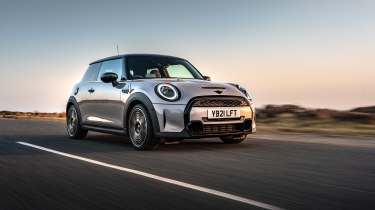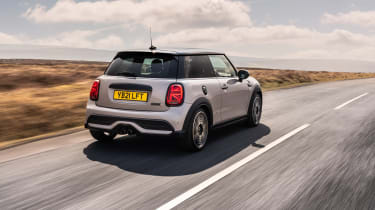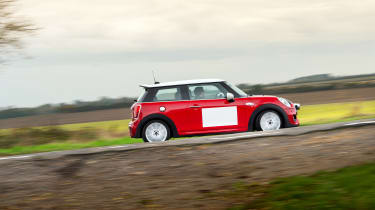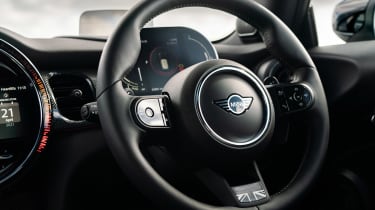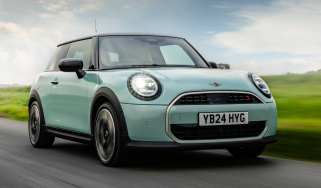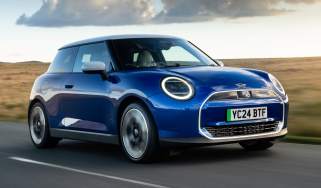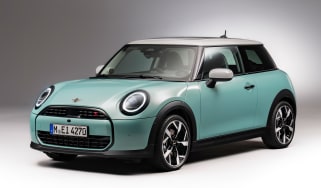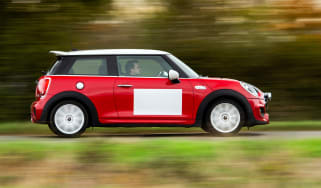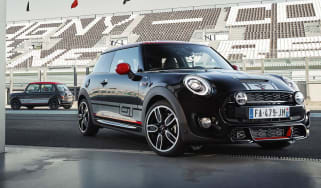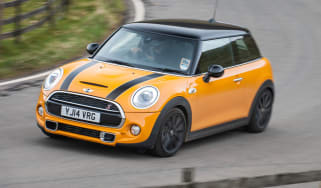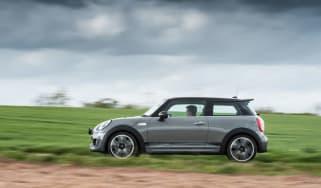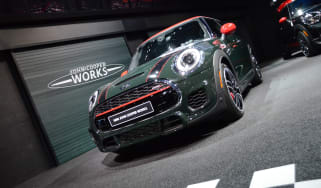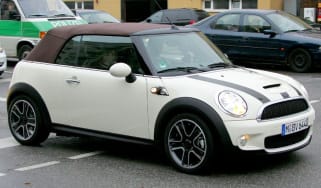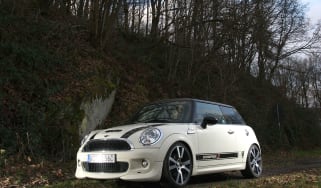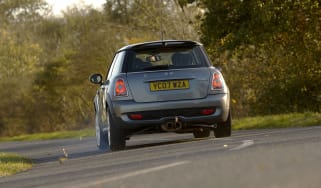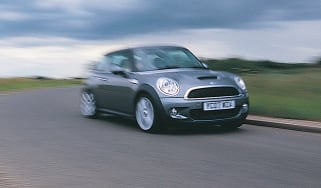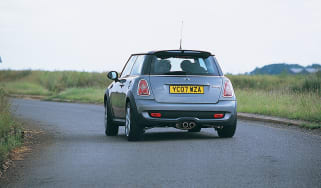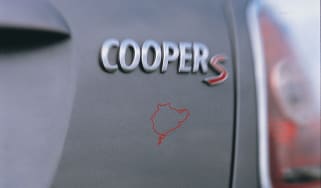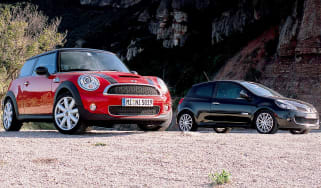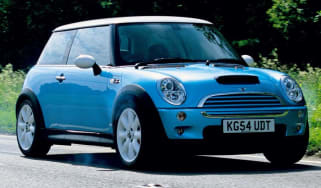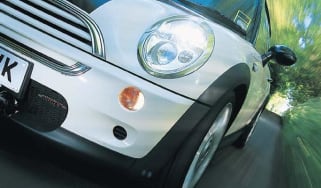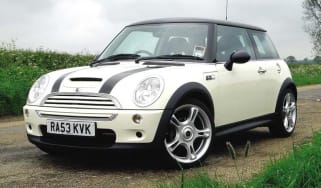Mini Cooper S (F56, 2014 - 2024) review – the last manual Mini
The F56 Mini Cooper S marked the end of an era for the Mini hatch, being the last to offer a manual transmission
The new Mini range has impressed most critics but divided opinion among Mini enthusiasts, meaning that some will be looking to the outgoing F56 Mini Cooper S (to which the new petrol models are closely related) rather than the latest greatest Mini Cooper S and John Cooper Works, for their hot Mini fix.
So successful was the introduction of BMW's ‘new Mini' in 2001 that not an awful lot in terms of its design sensibility changed over the course of 22 years, in spite of it growing in dimensions substantially. That was until the introduction of the new one last year, which in its electric trims dispensed with the rubber arches and lozenge rear lights and in all trims, ditched the manual gearbox, while the petrol Cooper S lost a good deal of its visual hot hatch edge.
While still contemporary, the F56 Cooper S that it succeeded is starting to feel its age. Nevertheless, the hot supermini still holds appeal with good pace, excellent build quality and an evergreen design. Over the years the rough edges of the original ‘new’ Mini Cooper S – the wonderfully oversupercharged R53-generation cars – were smoothed over. The Mini evolved to meet demands in the marketplace for a more premium, polished product, still with the unmistakable Mini design flare but with some maturity woven through its composition.
More reviews
Group tests
- Ariel Atom 4R v Caterham Seven ‘evo25’: power-to-weight heroes go head-to-head
- Aston Martin Vantage V600 v Aston Martin Vantage GT8 – limited-run Astons go head-to-head
- Aston Martin Vantage vs Audi R8 V10 RWD – back to basics
- BMW E30 M3 v E46 M3 CSL v F87 M2 CS
- BMW M8 Competition Gran Coupe vs Audi RS7 Sportback – battle of the alt-supersaloon
- Caterham Super Seven 600 v Super Seven 2000
- Levante v T1
- Corvette Stingray v Porsche Cayman GTS v Audi R8 RWD
- Great Ferrari hypercars driven: 288 GTO, F40, F50 and Enzo head-to-head
- Hardcore Ferrari V8 specials go head-to-head
In-depth reviews
- Abarth 600e 2024 review – Italian flair in an electric crossover?
- Alpine A110 review – distinctive, lightweight and unforgettable to drive
- Audi RS7 Sportback Performance review
- Bentley Continental R Mulliner: review, history and specs
- BMW 1-series review – Munich’s Audi A3 rival gains focus
- Cupra Leon 2025 review – the Golf GTI you want wears a Spanish frock
Long term tests
- Alfa Romeo Giulia Veloce Fast Fleet test – 7000 miles in the sharp Italian saloon
- Alpina B10: end of term report
- Alpina B10
- Alpina B10
- Alpina B10
- Ford Mustang GT
- Ford Mustang GT
- Ford Mustang GT
- Honda Civic Type R (FK8): living with it
- Land Rover Defender 110 Fast Fleet test – 9000 miles in the go-anywhere SUV
Review
- New Aston Martin DBS 770 Ultimate review – 759bhp super-GT driven
- New Bentley Batur 2023 review – can it possibly be worth £1.65m?
- 2023 Chevrolet Corvette C8 Z06 review – the American 911 GT3?
- Kia EV6 GT-Line S prototype review – the EV that shows how it’s done
- BBR Supercharged Mazda MX-5 (ND) 2023 review – tuned 250bhp roadster driven
- MG4 Trophy 2023 review
Reviews
- Abarth 695 75 Anniversario edition 2024 review – a fitting send-off for Abarth’s hot supermini?
- Abarth 500e 2023 review
- AC Cobra 378 Superblower MkIV 2021 review – another V8 Cobra, but with a GM heart this time
- Acura Integra Type S 2024 review – a Honda Civic Type R with added restraint
- Alfa Romeo Giulia Veloce 2023 review
- Alfa Romeo SZ: history, review and specs of an icon
- Alfa Romeo 1750 TBi
The F56 was fairly large by Mini standards, but its retro styling hides it well. Minis always feature contemporary technology and features too, with the F56 featuring LED headlights and a comprehensive infotainment system. In spite of its age, it still feels surprisingly grown-up and current. In its day the F56 had the likes of the Ford Fiesta ST and Hyundai's i20N to contend with for most accomplished go kart honours. They often bested the Mini as a driver’s car, in spite of the Mini’s particular brand of tack-sharp steering and waspish agility. The Mini of course fought back as the more stylish, high quality item, but all three have now been discontinued.
Mini Cooper S: in detail
- Engine, gearbox and technical specs – 2-litre four-cylinder engines are larger than the class norm, but deliver good power and torque through six-speed manual and seven-speed DCT gearboxes – the former the last of its kind
- Performance and 0-60 time – A 0-62mph time of under seven seconds is perfectly respectable. It’s a shame the engine isn’t more engaging to use, though
- Ride and handling – Sharp steering and a nimble chassis make the Cooper S fun to chuck around, but its talents don't run much deeper than that
- MPG and running costs – The Cooper S isn't a big drinker, and is able to match its on-paper mpg in the real world
- Interior and tech – Retro touches can be cloying in places and there’s not much space in three-door models, but it’s well built and the tech is up to date
- Design – Nothing else looks like a Mini, for better or worse. Huge range of personalisation means few Minis are ever alike
Used and nearly new Mini Cooper S (Mk3, F55/F56/F57)
The third generation of Cooper S is a great used buy. It’s not the cheapest of hot hatches as it depreciates more slowly than most competitors, but solid build quality ensures that even older models should be a reliable and enjoyable purchase. The Cooper S sold in significant numbers so there are plenty to choose from – look out for examples with an unblemished service history.
Our choice would be a manual machine, and the post-facelift Sport models offer lots of John Cooper Works goodies, making them an attractive buy. The basic three-door Mini Cooper S in entry-level ‘Classic’ specification was priced from £26,490 towards the end of its life, having suffered a £5k jump on prices in early 2020. Upgrading to ‘Sport’ trim bumped this to £28,390, and the more luxurious ‘Exclusive’ models were the same price as their Sport counterparts.
To this, you could add £700 if you wanted an extra pair of doors, or around £3000 for a fold-away convertible roof. That made a car that initially seemed like quite good value, quite expensive – a Cooper S Convertible in Sport trim was a near £30k car, a price that was tough to justify against more talented rivals.
Most of the very last Cooper S models that haven’t had huge miles put on them are sitting in the mid-20s, with really high-spec cars holding firm closer to £30,000. Higher mileage older examples from 2021 drop into the £20,000 range, and even the high teens. Early F56s with acceptably low miles and a decent spec are in the low teens.
Launched as a three-door model in 2014 the Cooper S used a 2-litre four-cylinder turbocharged engine that developed 189bhp. It was joined by the five-door model later that year, with the Convertible making its debut in 2015. There was a facelift in 2018 (and another minor update in 2021) which saw some styling and equipment changes, and from late 2018 three new trim levels were announced – Classic, Sport and Exclusive. Resolute spec joined the top of the range for its final flourish. The spicier JCW models are worth a mention, as is the slightly disappointing GP3 and finally, the 1to6 Edition – the last Mini to use a manual transmission.
Used Mini Cooper S (Mk1, R52/R53 2001-2008; Mk2 R56/R57 2007-2013)
The first of the ‘BMW’ Minis was launched in 2001, with the Cooper S (R53) hatch being added to the line-up in 2002 as the range-topping model. It used a supercharged 1.6-litre four-cylinder which was good for 168bhp. With a six-speed manual and multi-link rear suspension it was a hoot to drive and firmly established the model as a very desirable hot hatch. A convertible was made from 2004 to 2008, but the extra weight and a less solid body meant it wasn’t as involving as the hatch.
The second-generation Mini Cooper S was launched in 2007, with the previous model’s fizzy supercharged 1.6 ditched in favour of a turbocharged unit with 181bhp. The styling wasn’t quite as convincing as that of the earlier car, with the Mini having gained a little bit of middle-aged spread. Hydraulic power steering was ditched in favour of an electric set-up and overall it wasn’t quite as focussed a machine as the original Cooper S.
Rivals
The obvious alternative was the Ford Fiesta ST – that is before it went out of production in the middle of 2023. If you can find a good used example, it's a cracker; with 197bhp on tap it’s more muscular than the Mini, and its slightly boosty power delivery and offbeat soundtrack make its power plant more exciting too. It’s much lighter on its feet and sharper to drive.
The Hyundai i20 N also joined the scene – albeit for a frustratingly short stint – as the quintessential small hot hatch. While it was a difficult car to get a hold of, there was plenty of reason to pursue it as it’s just as fabulous to drive as the Ford. For something altogether more serious, the Toyota GR Yaris was also available, though the WRC-inspired special has now had its own hefty jump in price with the recent Gen 2 update. The GR really is a revelation to drive, though, which is reflected in strong used values.

